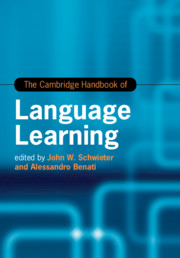Book contents
- The Cambridge Handbook of Language Learning
- Cambridge Handbooks in Language and Linguistics
- The Cambridge Handbook of Language Learning
- Copyright page
- Contents
- Figures
- Tables
- Contributors
- Acknowledgements
- Introduction
- Part I Theories
- Part II Methods
- 5 Qualitative Classroom Methods
- 6 Experimental Studies in L2 Classrooms
- 7 Action Research: Developments, Characteristics, and Future Directions
- 8 Classroom Observation Research
- 9 Psycholinguistic and Neurolinguistic Methods
- Part III Skill Development
- Part IV Individual Differences
- Part V Pedagogical Interventions and Approaches
- Part VI Context and Environment
- Part VII Moving Forward
- Index
- References
8 - Classroom Observation Research
from Part II - Methods
Published online by Cambridge University Press: 25 June 2019
- The Cambridge Handbook of Language Learning
- Cambridge Handbooks in Language and Linguistics
- The Cambridge Handbook of Language Learning
- Copyright page
- Contents
- Figures
- Tables
- Contributors
- Acknowledgements
- Introduction
- Part I Theories
- Part II Methods
- 5 Qualitative Classroom Methods
- 6 Experimental Studies in L2 Classrooms
- 7 Action Research: Developments, Characteristics, and Future Directions
- 8 Classroom Observation Research
- 9 Psycholinguistic and Neurolinguistic Methods
- Part III Skill Development
- Part IV Individual Differences
- Part V Pedagogical Interventions and Approaches
- Part VI Context and Environment
- Part VII Moving Forward
- Index
- References
Summary
This chapter is about second and foreign language (L2) classroom observation research, with a focus on observation instruments developed within the interaction analysis tradition. It begins with a brief description of classroom observation research and a comparison of interaction analysis with other approaches. This is followed by a general description of how observation instruments are organized, how they differ in terms of number and type of categories, coding procedures, units of analysis, and overall strengths and weaknesses. Four observation schemes are then described in detail with specific examples and illustrations of their categories along with information about the reasons for their development, the contexts in which they have been used, the type of research undertaken with them, and brief summaries of the findings associated with each. Throughout, there is an examination of how interaction analysis observation schemes have evolved in relation to the different phases of L2 classroom research, including the global method comparison studies, process and process-product research, and the shift from macro-level to micro-level descriptions of classroom behaviours. The chapter concludes with a discussion of the benefits of multi-method approaches to L2 classroom observation research.
- Type
- Chapter
- Information
- The Cambridge Handbook of Language Learning , pp. 186 - 207Publisher: Cambridge University PressPrint publication year: 2019
References
- 2
- Cited by



